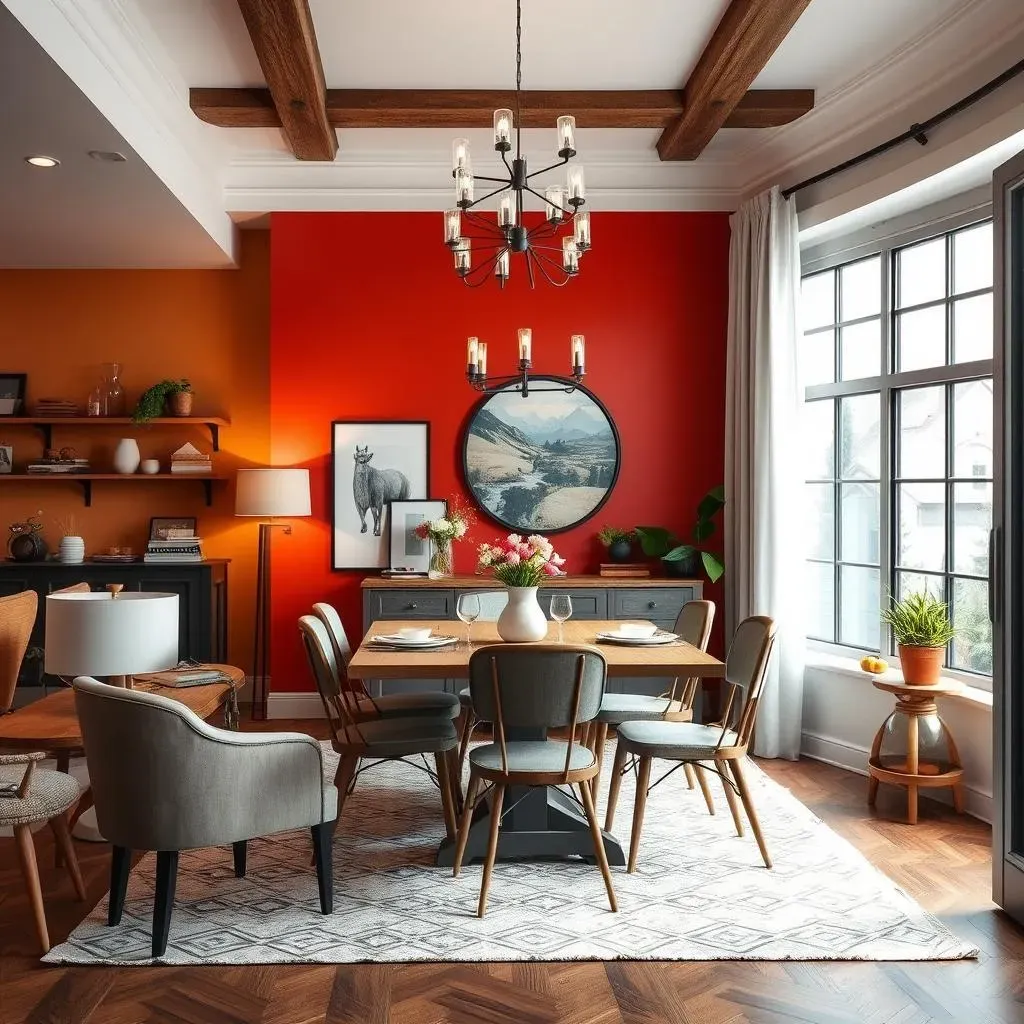Table of Contents
Ready to revamp your dining room without a full-scale renovation? An accent wall is your secret weapon! This article is your ultimate guide to choosing the perfect accent wall paint colors for your dining room. We'll explore a world of possibilities, showing you how the right color can transform your space from drab to fab. Get ready to discover how accent wall paint colors can dramatically alter the mood and style of your dining area, whether you're aiming for a cozy, rustic feel, a sleek modern aesthetic, or something completely unique. We'll cover everything from selecting the ideal shade and finish to finding inspiration for various dining room styles. Learn how to expertly choose colors that complement your existing furniture and décor, and discover tips and tricks for creating a truly stunning dining room that reflects your personal style. Let's dive into the exciting world of accent wall paint colors for dining rooms and unlock the potential of your space!
Choosing the Perfect Accent Wall Paint Colors for Your Dining Room
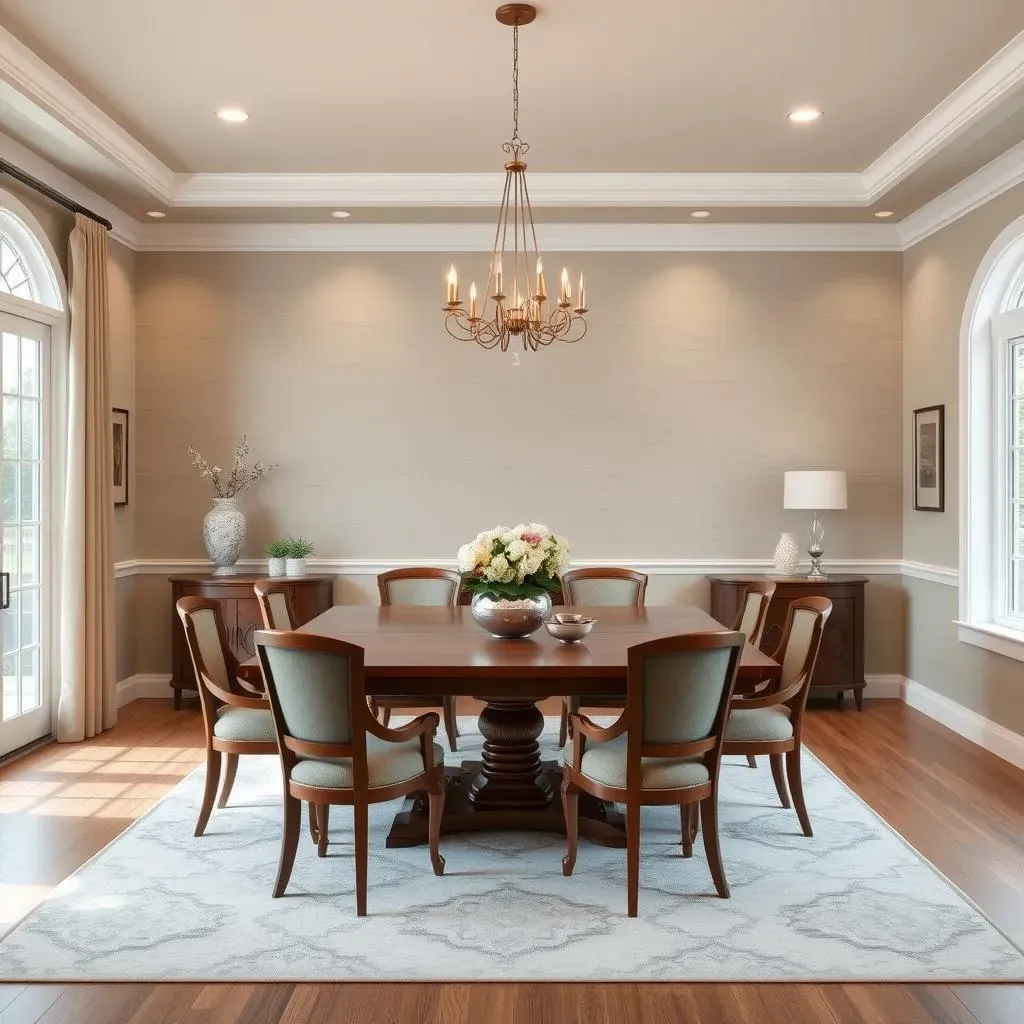
Choosing the Perfect Accent Wall Paint Colors for Your Dining Room
Understanding Your Space
Picking the right accent wall paint color for your dining room starts with understanding the room itself. Consider the size, lighting, and overall style. A small dining room with limited natural light might benefit from lighter, brighter colors to create an illusion of spaciousness. Check out our guide on accent wall colors for small rooms for more tips! In contrast, a large dining room with ample sunlight can handle bolder, darker shades to add drama and sophistication. Think about the existing furniture and décor – do you have a lot of wood tones? Bright colors? A cohesive color scheme will tie everything together nicely.
Think of the mood you want to create. Do you envision a calming, relaxing space for intimate dinners, or a vibrant, energetic area perfect for lively gatherings? The color you choose will heavily influence the overall atmosphere. For instance, warm colors like reds and oranges evoke feelings of warmth and comfort, while cooler colors like blues and greens can create a sense of serenity. If you're unsure, consider experimenting with different color palettes using our color combination guides to see what works best with your existing furniture.
Room Size | Lighting | Recommended Color Palette |
|---|---|---|
Small | Low | Light, bright colors (e.g., whites, pastels) |
Large | High | Bolder, darker shades (e.g., deep blues, jewel tones) |
Medium | Medium | Versatile neutrals (e.g., grays, beiges) |
Exploring Color Psychology
Color psychology plays a surprisingly significant role in how we perceive a space. Different colors evoke different emotions and can impact our dining experience. For example, warm colors like reds and yellows stimulate appetite and encourage conversation, making them excellent choices for creating a lively dining atmosphere. However, using too many warm colors can also make a room feel smaller than it actually is. Alternatively, cooler colors like blues and greens promote calmness and relaxation, perfect for more intimate settings. However, too much cool color can make a space feel cold and uninviting. Finding the right balance is key!
Consider the practical aspects. Will the color complement your existing furniture and artwork? Will it clash with your flooring or other elements in the room? A good rule of thumb is to select an accent wall color that either complements or contrasts subtly with the rest of the room's color scheme. A complementary color is one that sits opposite your main color on the color wheel, creating a visually striking contrast. For example, a blue accent wall would beautifully contrast with a kitchen with orange cabinets. However, a contrasting color can sometimes make the space feel disjointed. A harmonious color scheme is created by using colors that are next to one another on the color wheel. This creates a soothing and elegant effect. This is a great option for those who prefer a more unified feel in their dining room. If you need help choosing colors that coordinate well, consider consulting our guide on choosing colors that work together.
- Warm colors (reds, oranges, yellows): Stimulate appetite, encourage conversation.
- Cool colors (blues, greens): Promote calmness, relaxation.
- Neutrals (grays, beiges): Versatile, create a balanced feel.
Accent Wall Ideas for Different Dining Room Styles: From Rustic to Modern
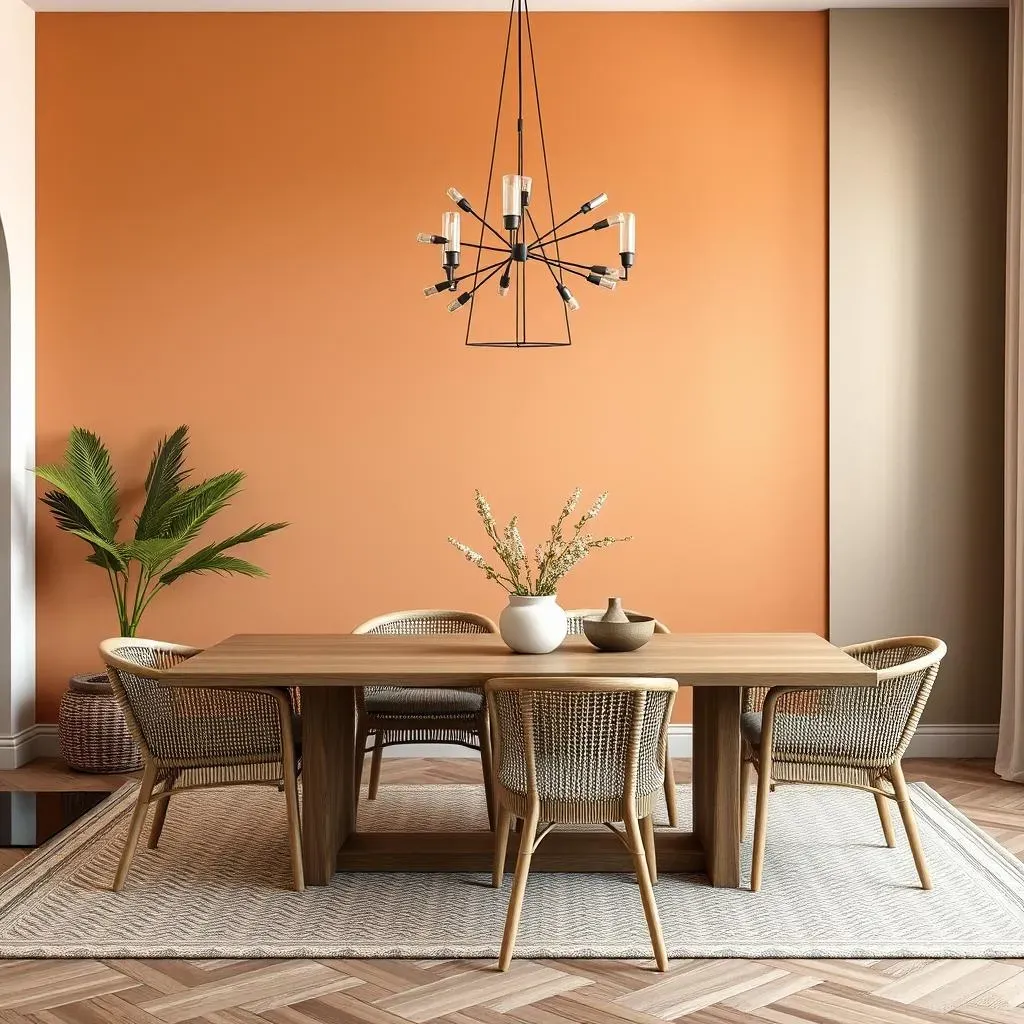
Accent Wall Ideas for Different Dining Room Styles: From Rustic to Modern
Let's talk accent walls! The beauty of an accent wall is its versatility. It can completely change the vibe of your dining room depending on the style you choose. A rustic dining room, for instance, might sing with a warm, earthy tone. Think deep terracotta, a weathered wood effect (achieved with paint, of course!), or a charming sage green. These colors evoke a sense of cozy comfort and connection to nature. Check out these brown-toned paint ideas for inspiration! Pairing a rustic accent wall with natural wood furniture and woven textures creates a truly inviting space. For a more polished, yet still rustic feel, try a stone-like gray or even a muted beige.
Now, let's flip the script to a modern dining room. Here, you've got a playground for bold choices! Think sleek geometric patterns (check out our geometric pattern ideas), vibrant jewel tones like emerald green or sapphire blue, or a sophisticated charcoal gray. A clean, minimalist look is often enhanced by a single, statement accent wall in a rich, saturated color. Metallic accents—gold, silver, or even copper—can beautifully complement these modern palettes. Consider pairing a dark accent wall with lighter furniture to create a sense of contrast and visual interest.
- Rustic: Earthy tones (terracotta, sage green, muted beige), wood textures.
- Modern: Bold colors (jewel tones, charcoal gray), geometric patterns, metallic accents.
- Traditional: Classic neutrals (cream, soft gray), subtle patterns or textures.
For a traditional dining room, you'll want to lean towards classic elegance. Subtle patterns, soft textures, or a classic neutral color palette are your best bets. Think soft creams, gentle grays, or even a sophisticated muted blue. These colors create a timeless and refined atmosphere. Adding a subtle pattern, like a damask or a subtle stripe, can elevate the traditional look further. These patterns can be achieved using stencils or even painter's tape for a DIY approach. You can also explore our two-tone accent wall ideas for a touch of sophistication. A traditional dining room can benefit from a classic color pairing, such as a cream accent wall with navy blue trim.
Don't forget about eclectic styles! Eclectic dining rooms are all about mixing and matching. You can create a truly unique look by combining elements from different styles. For example, you could pair a bold, modern accent wall with vintage furniture and quirky artwork. The possibilities are endless! An eclectic space might benefit from an ombre effect, using a gradient of colors to create a visually interesting focal point. You could also explore different paint finishes to add another layer of texture and depth. For instance, a matte finish can add a sense of warmth, while a glossy finish can create a more modern, polished look. We have some stunning paint finish ideas to inspire you!
Style | Color Palette | Texture/Pattern |
|---|---|---|
Rustic | Earthy tones, warm neutrals | Wood grain, textured plaster |
Modern | Bold colors, metallics, neutrals | Geometric patterns, clean lines |
Traditional | Classic neutrals, pastels | Subtle patterns, damask |
Eclectic | Mix and match | Variety of textures, patterns |
How to Choose the Right Paint Colors and Finishes for Your Accent Wall
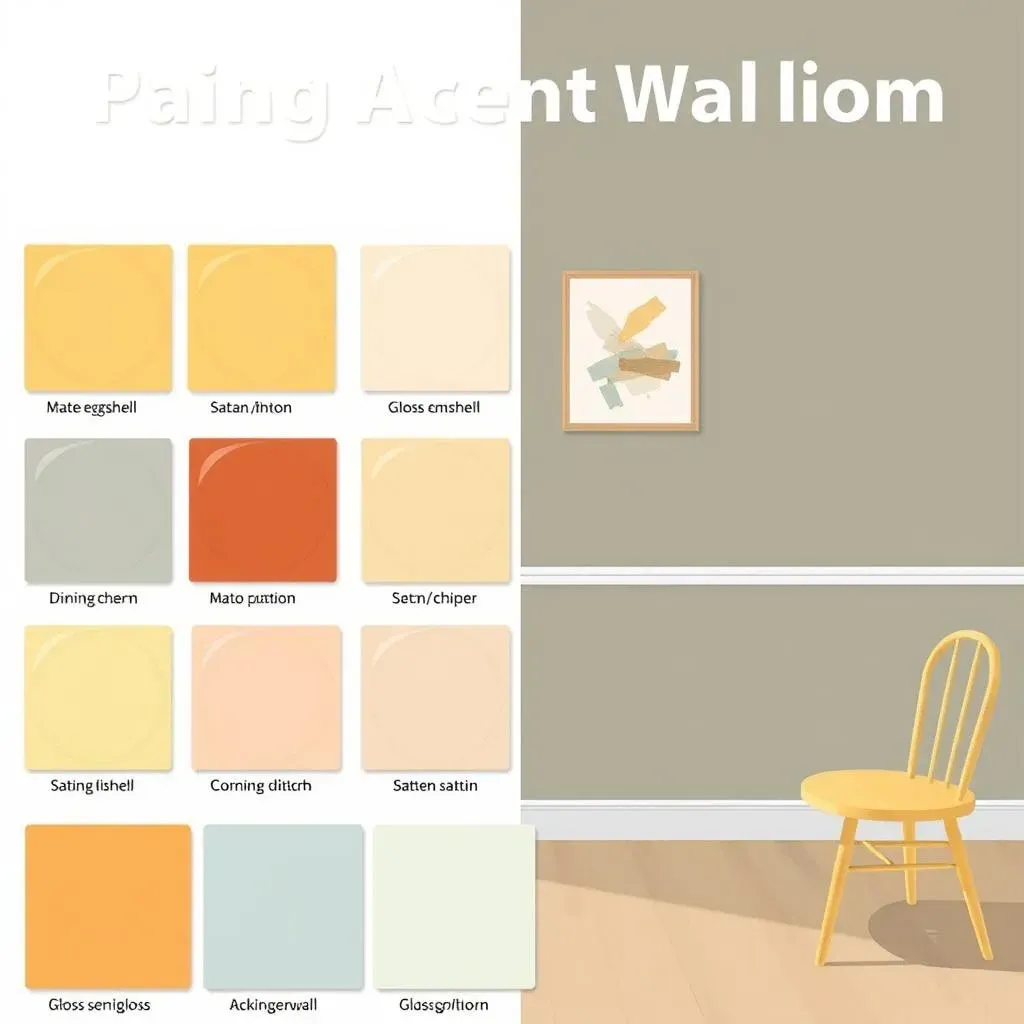
How to Choose the Right Paint Colors and Finishes for Your Accent Wall
So, you've got your dining room style figured out, and you're ready to pick the perfect paint. Fantastic! Now let's talk about choosing the *right* paint colors and finishes for that stunning accent wall. This isn't just about picking a pretty shade; it's about making a statement that enhances your dining experience. First, let's talk about color. Remember those color psychology tips from earlier? Keep them in mind as you browse paint swatches. Don't be afraid to experiment with different shades before committing to a whole gallon! Many paint stores offer small sample sizes, which are perfect for testing out colors on your wall before fully committing. This allows you to see how the color looks in your specific lighting conditions, at different times of the day, and in relation to your existing décor. If you need a little extra help choosing the perfect shade, check out our guide on choosing paint colors that complement gray.
Next, let's discuss paint finishes. The finish you choose can significantly impact the overall look and feel of your accent wall. Matte finishes offer a subtle, sophisticated look, perfect for creating a cozy and intimate atmosphere. Eggshell finishes provide a slightly more durable, washable surface, ideal for high-traffic areas. Satin finishes offer a bit more sheen and are easier to clean, making them a practical choice for dining rooms. Finally, gloss and semi-gloss finishes offer the most shine and durability, but they can highlight imperfections in the wall's surface. Choosing the right finish depends on your personal preference and the level of durability you need. For more finish ideas, explore our collection of accent wall paint finish ideas.
- Matte: Subtle, sophisticated, cozy.
- Eggshell: Durable, washable.
- Satin: Easy to clean, slightly more sheen.
- Gloss/Semi-gloss: Most durable, shiny, highlights imperfections.
Before you grab your brushes, remember that preparation is key! Properly preparing your wall surface will ensure a smooth, even finish and prevent any surprises down the road. Start by cleaning the wall thoroughly to remove any dirt, dust, or cobwebs. This will help the paint adhere properly and prevent peeling or chipping. Next, fill any holes or cracks with spackle and sand them smooth. This will create a flawless surface for your paint. Finally, prime the wall before painting. Primer helps the paint adhere better, resulting in a more even coat and vibrant color. A good quality primer can also help to cover any stains or imperfections on the wall. Remember, a well-prepared wall is the foundation for a stunning accent wall!
Now that you've chosen your paint and finish and prepped your wall, you're ready to paint! Consider using painter's tape to create crisp lines and prevent bleeding if you're adding any patterns or designs. Apply thin, even coats of paint, allowing each coat to dry completely before applying the next. For a professional finish, use a high-quality paintbrush or roller. And remember, don't rush the process! Taking your time will ensure a beautiful, long-lasting accent wall that you can enjoy for years to come. For more detailed instructions, check out our how to paint an accent wall guide. Once your accent wall is complete, step back and admire your handiwork. You've transformed your dining room into a space that is uniquely you!
Paint Finish | Pros | Cons |
|---|---|---|
Matte | Subtle, hides imperfections | Not very durable, difficult to clean |
Eggshell | Durable, washable | Shows some imperfections |
Satin | Durable, washable, some sheen | More likely to show imperfections |
Semi-gloss/Gloss | Very durable, washable, shiny | Highlights imperfections |
Creating a Stunning Dining Room with Accent Walls: Tips and Inspiration
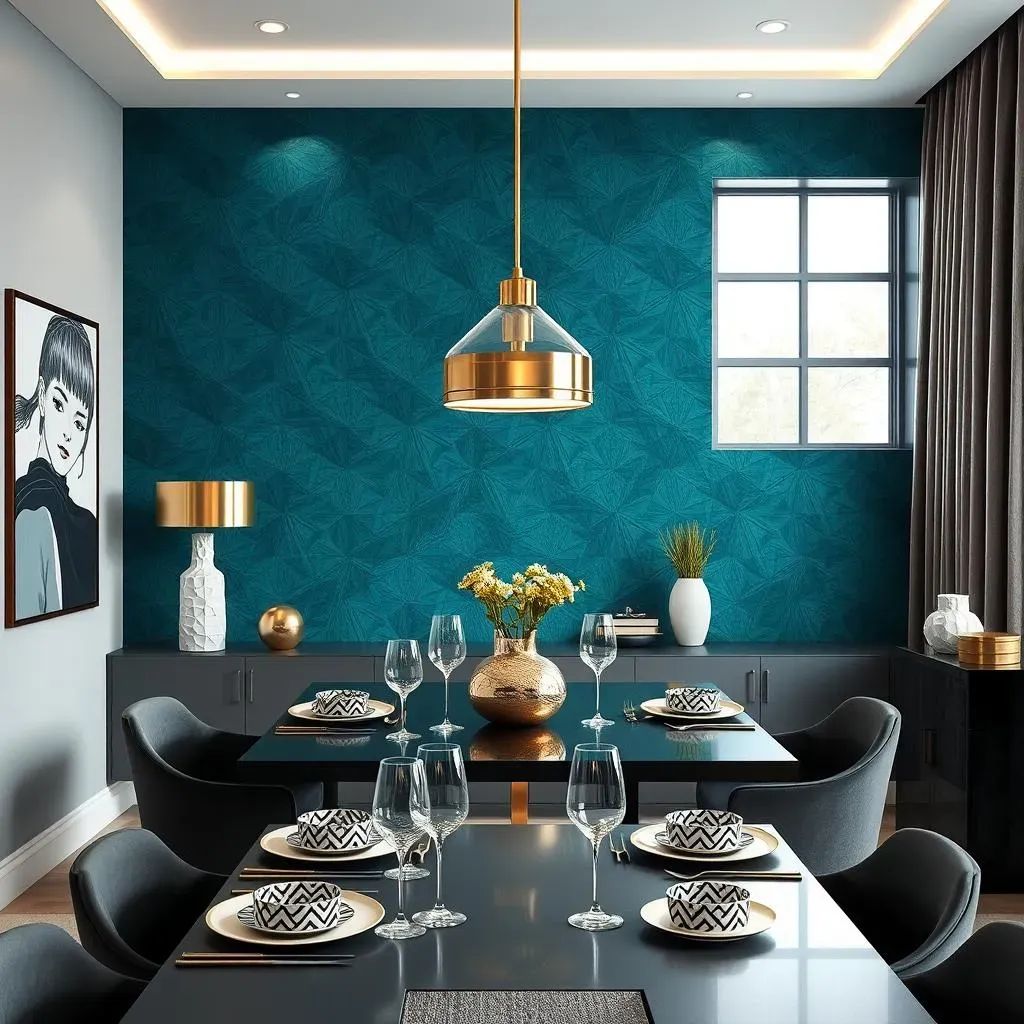
Creating a Stunning Dining Room with Accent Walls: Tips and Inspiration
Adding Personality with Accessories
Once your accent wall is painted, don't stop there! Accessories are your secret weapons for creating a truly stunning dining room. Think about the overall style you're aiming for. A rustic dining room might benefit from woven placemats, a wooden centerpiece, and a collection of vintage plates. These elements add texture and visual interest, complementing the warmth of your earthy accent wall. For a more modern space, consider sleek metallic accents, geometric patterned tableware, and minimalist artwork. These elements enhance the clean lines and sophistication of your chosen color palette. Remember, the goal is to create a cohesive look that ties all the elements of your dining room together. For more ideas on how to style your dining room, check out our guide on accent wall paint colors for dining rooms!
Lighting is another critical element to consider. The right lighting can dramatically enhance the look of your accent wall and create the desired mood in your dining room. Consider using a statement chandelier or pendant light to draw attention to your accent wall. Recessed lighting or strategically placed sconces can also provide ambient lighting, highlighting the color and texture of your wall. For a more dramatic effect, try using dimmer switches to adjust the lighting intensity depending on the occasion. If you’re looking to create a softer, more intimate atmosphere, consider incorporating candles or other soft lighting sources. For more dining room lighting inspiration, check out our article on dining room accent wall ideas.
- Rustic: Woven placemats, wooden centerpiece, vintage plates.
- Modern: Metallic accents, geometric patterns, minimalist artwork.
- Traditional: Classic tableware, subtle patterns, elegant lighting.
Creating a Focal Point
One of the most effective ways to use an accent wall is to create a focal point in your dining room. This could be as simple as choosing a bold color that contrasts with the rest of the room, or it could involve incorporating a more complex design element, such as a mural or a large piece of artwork. Regardless of your approach, the goal is to draw the eye to the accent wall and create a sense of visual interest. A well-placed focal point can make your dining room feel more balanced and inviting. Remember to consider the size and shape of your dining room when choosing a focal point. In a smaller space, a large, bold focal point might feel overwhelming. In a larger space, you have more flexibility to experiment with size and scale. The placement of your furniture can also impact the effectiveness of your focal point. For example, positioning a dining table in front of your accent wall can draw attention to both the table and the wall itself. For more inspiration on creating focal points in your dining room, check out our ideas on dining room accent walls.
Finally, don't be afraid to experiment and have fun! Choosing an accent wall color and designing your dining room is a creative process. There are no hard and fast rules, so feel free to express your personal style. The most important thing is to create a space that you love and that reflects your personality. If you're still feeling stuck, consider browsing through design magazines, websites, and social media for inspiration. You can also consult with a professional interior designer for personalized advice. Remember, your dining room should be a place where you feel comfortable, relaxed, and inspired. With a little creativity and planning, you can create a dining room that is both stylish and functional. And don't forget to share your stunning creations with us! We'd love to see how you've transformed your dining space using our tips and inspiration. For some final inspiration, check out our gallery of dining room accent wall paint ideas.
Focal Point Idea | Style | Effect |
|---|---|---|
Bold color contrast | Modern, eclectic | Dramatic, eye-catching |
Subtle pattern or texture | Traditional, rustic | Elegant, understated |
Large artwork or mirror | Any style | Statement piece, adds personality |
